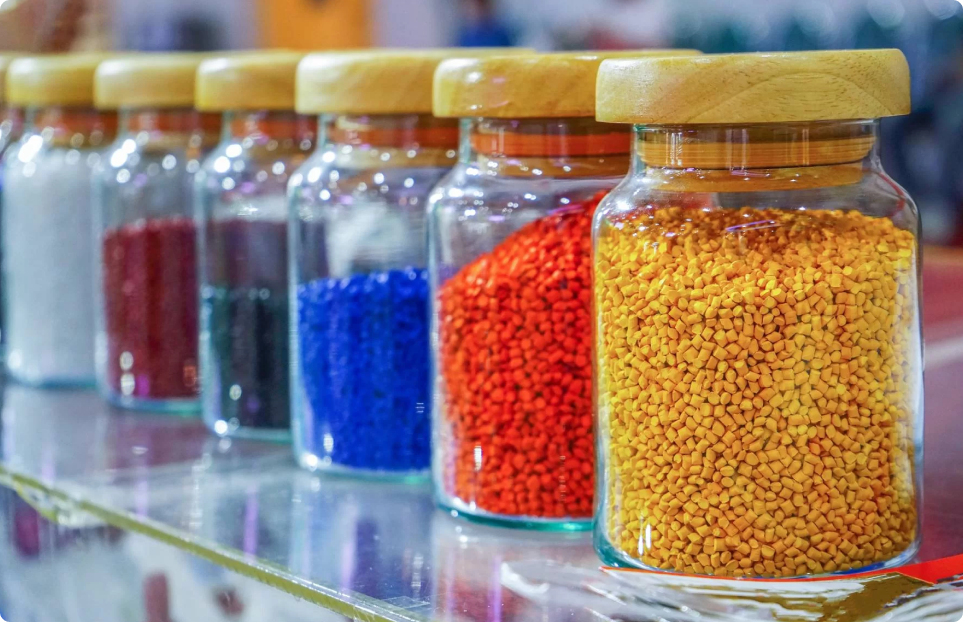
June 26, 2024
The Versatility of Plastic Granules
Reprocessed granules, also known as recycled plastic granules, are a sustainable alternative to virgin plastic granules. They are manufactured by taking plastic waste, sorting it by type, and then processing it into usable pellets. These pellets can then be used in a variety of applications, similar to virgin plastic granules.
Reprocessed granules come in various forms, each with its own characteristics:
High-Density Polyethylene (HDPE)
High-density polyethylene (HDPE) granules are a cornerstone of the plastics industry, valued for their strength, durability, and wide range of applications. This blog dives deep into the world of HDPE granules, exploring their properties, production process, and common uses.
Properties of HDPE Granules:
High Strength and Durability: HDPE boasts exceptional strength and impact resistance, making it suitable for demanding applications.
Chemical Resistance: HDPE is resistant to a wide range of chemicals, including acids, alkalis, and alcohols, allowing it to be used in various environments.
Lightweight: Despite its strength, HDPE is a relatively lightweight material, offering advantages in applications where weight reduction is crucial.
Moisture Resistance: HDPE exhibits excellent moisture resistance, making it ideal for applications exposed to water or humid conditions.
Good Electrical Insulation: HDPE possesses good electrical insulating properties, finding use in electrical components and wire insulation.
Recyclability: HDPE is one of the most readily recyclable plastics, contributing to a more sustainable plastic life cycle.
Production Process of HDPE Granules:
HDPE granules are produced through a process called naphtha cracking, followed by polymerization:
Naphtha Cracking: Naphtha, a liquid hydrocarbon derived from crude oil, is cracked into simpler molecules like ethylene at high temperatures and pressures.
Polymerization: Ethylene molecules are then linked together in a controlled polymerization process to form long chains, creating HDPE.
Extrusion and Pelletization: The molten HDPE is extruded into strands, cooled, and chopped into small, cylindrical pellets – the HDPE granules we see.
Additives: During the process, specific additives might be incorporated to enhance specific properties of the final HDPE granules, such as antioxidants for improved UV resistance or colorants for pigmentation.
Applications of HDPE Granules:
The versatility of HDPE granules translates into a vast array of applications, including:
Packaging: HDPE is a prominent material for bottles, containers, jugs, and caps due to its durability, chemical resistance, and lightweight properties.
Pipes and Tubes: HDPE pipes are widely used for potable water distribution, drainage systems, and industrial applications due to their strength, flexibility, and corrosion resistance.
Construction Materials: HDPE finds use in construction applications like geomembranes (liners for landfills and ponds), building materials, and composite lumber.
Chemical Storage: HDPE tanks and containers are suitable for storing various chemicals due to their chemical resistance.
Medical Devices: Certain medical devices and prosthetics can be made from HDPE due to its biocompatibility and sterilizability.
Household Products: HDPE is used in various household items like buckets, toys, and furniture components.
Low-Density Polyethylene (LDPE):
Low-density polyethylene (LDPE) granules are the workhorses of the flexible plastic world. Renowned for their ease of processing, clarity, and cost-effectiveness, they find application in a vast array of products we encounter daily. Let’s delve into the world of LDPE granules, exploring their properties, production process, common uses, and factors to consider when choosing them.
Properties of LDPE Granules:
Flexibility and Formability: LDPE boasts excellent flexibility, making it ideal for applications requiring easy shaping and forming into various films and products.
Moisture Barrier: LDPE offers a good moisture barrier, protecting contents from external moisture and maintaining product integrity.
Chemical Resistance: While not as extensive as HDPE, LDPE exhibits resistance to a range of chemicals, including mild acids and alkalis.
Transparency: LDPE granules can be formulated to be highly transparent, making them suitable for clear packaging applications.
Lightweight: LDPE is a lightweight plastic, contributing to reduced transportation costs and energy efficiency during product formation.
Reclaimability: LDPE is readily recyclable, contributing to a more sustainable plastic life cycle.
Production Process of LDPE Granules:
Similar to HDPE, LDPE granules are produced through a process involving naphtha cracking and polymerization:
Naphtha Cracking: Naphtha, a liquid hydrocarbon derived from crude oil, is cracked into simpler molecules like ethylene at high temperatures and pressures.
Polymerization: Ethylene molecules undergo a controlled polymerization process, where they link together to form long, branched chains, creating LDPE. The branching in the polymer chains contributes to LDPE’s flexibility compared to HDPE’s more linear structure.
Extrusion and Pelletization: The molten LDPE is extruded into strands, cooled, and chopped into small, cylindrical pellets – the LDPE granules we see.
Additives: Similar to HDPE, specific additives might be incorporated during processing to enhance specific properties. Antioxidants can be added to improve UV resistance, and colorants can be used for pigmentation.
Applications of LDPE Granules:
The unique properties of LDPE granules translate into a wide range of applications, including:
Packaging: LDPE is a dominant material for flexible packaging, including grocery bags, shrink wrap, food wraps, and pouches. Its transparency and moisture barrier properties make it ideal for showcasing products and protecting them from spoilage.
Stretch Film: LDPE granules are used to produce stretch film, a valuable material for palletization and securing goods during transport.
Trash Bags: LDPE’s flexibility and low cost make it the go-to material for manufacturing trash bags.
Liners: LDPE liners are used in various applications, including trash can liners, pond liners, and geomembranes for landfills due to their moisture barrier properties.
Squeezable Bottles: LDPE’s flexibility makes it suitable for manufacturing squeezable bottles for various products like ketchup, mustard, and detergents.
Consumer Goods: LDPE finds use in various consumer goods like toys, lids, and closures due to its formability and cost-effectiveness.
Conclusion
Reprocessed granules, composed of recycled HDPE and LDPE plastics, offer a sustainable alternative to virgin plastic granules. They possess many of the same valuable properties like strength, durability, chemical resistance, and lightweight design. Understanding the distinct characteristics of HDPE and LDPE granules allows for informed decisions in manufacturing and product design across a vast array of applications, from packaging and construction to medical devices and household products. By choosing reprocessed granules, we can contribute to a more sustainable future by reducing reliance on virgin plastic materials and minimizing plastic waste.


